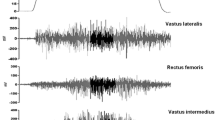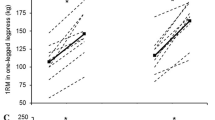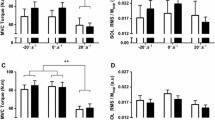Abstract
Effects of a 24-week strength training performed twice weekly (24 ST) (combined with explosive exercises) followed by either a 3-week detraining (3 DT) and a 21-week re-strength-training (21 RST) (experiment A) or by a 24-week detraining (24 DT) (experiment B) on neural activation of the agonist and antagonist leg extensors, muscle cross-sectional area (CSA) of the quadriceps femoris, maximal isometric and one repetition maximum (1-RM) strength and jumping (J) and walking (W) performances were examined. A group of middle-aged (M, 37–44 years, n=12) and elderly (E, 62–77, n=10) and another group of M (35–45, n=7) and E (63–78, n=7) served as subjects. In experiment A, the 1-RM increased substantially during 24 ST in M (27%, P < 0.001) and E (29%, P < 0.001) and in experiment B in M (29%, P < 0.001) and E (23%, P < 0.01). During 21 RST the 1-RM was increased by 5% at week 48 (P < 0.01) in M and 3% at week 41 in E (n.s., but P < 0.05 at week 34). In experiment A the integrated electromyogram (IEMG) of the vastus muscles in the 1-RM increased during 24 ST in both M (P < 0.05) and E (P < 0.001) and during 21 RST in M for the right (P < 0.05) and in E for both legs (P < 0.05). The biceps femoris co-activation during the 1-RM leg extension decreased during the first 8-week training in M (from 29 ± 5% to 25 ± 3%, n.s.) and especially in E (from 41 ± 11% to 32 ± 9%, P < 0.05). The CSA increased by 7% in M (P < 0.05) and by 7% in E (P < 0.001), and by 7% (n.s.) in M and by 3% in E (n.s.) during 24 ST periods. Increases of 18% (P < 0.001) and 12% (P < 0.05) in M and 22% (P < 0.001) and 26% (P < 0.05) in E occurred in J. W speed increased (P < 0.05) in both age groups. The only decrease during 3 DT was in maximal isometric force in M by 6% (P < 0.05) and by 4% (n.s.) in E. During 24 DT the CSA decreased in both age groups (P < 0.01), the 1-RM decreased by 6% (P < 0.05) in M and by 4% (P < 0.05) in E and isometric force by 12% (P < 0.001) in M and by 9% (P < 0.05) in E, respectively, while J and W remained unaltered. The strength gains were accompanied by increased maximal voluntary neural activation of the agonists in both age groups with reduced antagonist co-activation in the elderly during the initial training phases. Neural adaptation seemed to play a greater role than muscle hypertrophy. Short-term detraining led to only minor changes, while prolonged detraining resulted in muscle atrophy and decreased voluntary strength, but explosive jumping and walking actions in both age groups appeared to remain elevated for quite a long time by compensatory types of physical activities when performed on a regular basis.
Similar content being viewed by others
Author information
Authors and Affiliations
Additional information
Accepted: 2 May 2000
Rights and permissions
About this article
Cite this article
Häkkinen, K., Alen, M., Kallinen, M. et al. Neuromuscular adaptation during prolonged strength training, detraining and re-strength-training in middle-aged and elderly people. Eur J Appl Physiol 83, 51–62 (2000). https://doi.org/10.1007/s004210000248
Issue Date:
DOI: https://doi.org/10.1007/s004210000248




